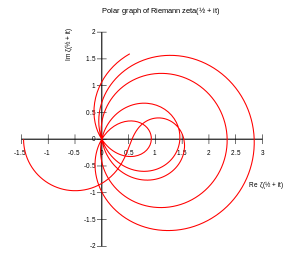
The real part (red) and imaginary part (blue) of the Riemann zeta-function along the critical line Re(s) = 1/2. You can see the first non-trivial zeros at Im(s) = ±14.135, ±21.022 and ±25.011.
The Riemann hypothesis (also called the Riemann zeta-hypothesis), first formulated by Bernhard Riemann in 1859, is one of the most famous and important unsolved problems in mathematics. It has been an open question for almost 150 years, despite attracting concentrated efforts from many outstanding mathematicians. Unlike some other celebrated problems, it is more attractive to professionals in the field than to amateurs.
The Riemann hypothesis (RH) is a conjecture about the distribution of the zeros of the Riemann zeta-function ζ(s). The Riemann zeta-function is defined for all complex numbers s ≠ 1. It has zeros at the negative even integers (i.e. at s = −2, s = −4, s = −6, ...). These are called the trivial zeros. The Riemann hypothesis is concerned with the non-trivial zeros, and states that:
The real part of any non-trivial zero of the Riemann zeta function is ½.
Thus the non-trivial zeros should lie on the so-called critical line, ½ + it, where t is a real number and i is the imaginary unit. The Riemann zeta-function along the critical line is sometimes studied in terms of the Z-function, whose real zeros correspond to the zeros of the zeta-function on the critical line.
The Riemann hypothesis is one of the most important open problems of contemporary mathematics, mainly because a large number of deep and important other results have been proven under the condition that it holds. Most mathematicians believe the Riemann hypothesis to be true. (J. E. Littlewood and Atle Selberg have been reported as skeptical. Selberg's skepticism, if any, waned from his young days. In a 1989 paper, he suggested that an analogue should hold for a much wider class of functions, the Selberg class.) A $1,000,000 prize has been offered by the Clay Mathematics Institute for the first correct proof.

A value graph of zeta, that is, Re(zeta) vs. Im(zeta), along the critical line s = it + 1/2, with t running from 0 to 34.
Hiç yorum yok:
Yorum Gönder